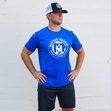Unleashing Your Athletic Potential: A Guide to Sport-Specific Strength Training
Ever wonder why athletes in different sports have their unique workout regimes? That’s because of something called sport-specific strength training. It’s not just about bulking up in the gym, but targeting those exercises that enhance your performance in your chosen sport.
And that’s exactly what this guide is all about! We’re going to break down how you can build your very own sport-specific strength training program. Whether want to learn how to dunk basketballs or increase your speed on and off the field, there’s a training plan that’s perfectly tailored for you.
Designing a Sport-Specific Strength Training ProgramReady to level up your game with sport-specific strength training? First things first, we need to tailor a training program just for you. Let’s put our game face on and get started with the basics.
Evaluating Fitness LevelBefore we break a sweat, it’s important to understand your current fitness level. This isn’t a competition. Instead, it’s all about understanding where you’re at before you start chasing your goal. Starting with basics like timing a run or counting push-ups in a minute can give you this baseline.
Having an accurate baseline gives us a clear picture of what your training program should focus on. It helps in tailoring the workouts to strengthen your weaknesses and further enhance your strengths. Isn’t that what sport-specific strength training is all about?
Remember, this fitness level evaluation isn’t a one-time thing. As you progress in your training, reevaluating will help you see the fruits of your labor. Plus, it is a great motivator to keep going!
Setting GoalsGoal setting in sport-specific strength training isn’t just about winning. It’s improving those aspects of your fitness that matter in your sport.
Your goals could be improving your vertical leap if you’re into basketball or working on your endurance for soccer. The trick here is to be specific and realistic. You can use the SMART criteria to guide you.
Once you have your goals locked down, keep them in sight. Not just mentally but physically too. Write them down where you can see them often, perhaps on a vision board or a sticky note on your mirror. This serves as a constant reminder and a source of motivation.
Developing a PlanNow comes the best part—developing your personalized plan! A well-crafted plan is the heart of sport-specific strength training and sets the tone for your fitness journey.
To develop a plan, make a list of exercises that tie back to your sport and your goals first. If you’re a basketball player aiming to improve your leap, plyometric workouts might be your ally. Remember, a variety of exercises will not only help target various muscles but also keep you from getting bored.
Keep in mind this plan is not set in stone. As you train, you will evolve, and so will your needs and, therefore, the training plan. Be open to changes as they come, tweak your plan as needed, and most importantly, enjoy the process!
Creating a Sport-Specific Strength Training Program for Basketball

Elevate your basketball skills with a tailored training program that focuses on the unique demands of the sport. Enhance your performance on the court through exercises and drills designed to optimize your agility, power, and shooting accuracy.
Endurance TrainingEndurance is a vital component of basketball, as it requires continuous movement and stamina on the court. Incorporating this into your basketball-specific strength program can greatly improve your performance. Consider adding activities like long-distance running, swimming, or rowing to enhance your cardiovascular fitness, increase stamina, and enable you to maintain a high level of intensity throughout the game.
Agility and Speed ExercisesTo improve agility, incorporate shuttle runs, ladder drills, or cone drills into your training routine. These exercises challenge your coordination, quickness, and ability to change direction rapidly. For speed training, focus on exercises that emphasize acceleration and quickness. Sprints, interval training, and agility ladder drills can help improve your speed, reaction time, and overall explosiveness.
Strength TrainingTo target key muscle groups used in basketball, include exercises such as lunges, squats, deadlifts, and bench presses. These compound movements engage multiple muscles simultaneously, improving your overall strength and power. Additionally, incorporating plyometric exercises like box jumps, medicine ball throws, and explosive push-ups can further enhance your explosiveness and jumping ability.
Shooting PracticeOne effective way to practice shooting at home is by using an indoor basketball hoop. Set up the hoop in a suitable location and focus on various shooting exercises such as spot shooting, free throws, and shooting off the dribble. This will improve your shooting mechanics and enhance your confidence and consistency in game-like situations. Remember to maintain proper shooting form, focusing on your footwork, hand placement, and follow-through.
Implementing a Sport-Specific Strength Training ProgramNow that you have designed your strength training program, it’s time to put it into action. Get ready to take your training to the next level and unlock your full potential on the field, court, or track.
Initial PhaseDuring the initial phase, prioritize proper form and technique while gradually increasing the intensity. Start with lighter weights or lower-resistance exercises to allow your body to adapt and reduce the risk of injury. Focus on mastering the fundamental movements and exercises specific to your sport.
Give yourself adequate rest and recovery time between workouts to allow your muscles to repair and rebuild. Consistency is key, so be sure to stick to your training schedule and gradually progress during the initial phase to set the stage for continued improvement and success.
ProgressionAs you become more comfortable with the exercises, gradually increase the intensity to challenge your muscles and continue to see progress. This can be done by increasing the weight you lift, adding more repetitions or sets, or reducing the rest periods between exercises.
Progress at a rate that is appropriate for your fitness level and allows your body to adapt. Pushing too hard or progressing too quickly can increase the risk of injury. Always listen to your body and pay attention to any signs of fatigue or discomfort.
ConsistencyConsistency is the secret ingredient that can take your sport-specific strength training to the next level. It’s not enough to have a well-designed program—you need to stick to it. This means showing up and putting in the work, even on days when you don’t feel motivated or energized.
However, it’s equally important to listen to your body and understand when rest is necessary. Overtraining can lead to burnout and increase the risk of injury. Rest days provide your muscles with time to recover and rebuild, allowing you to come back stronger for your next workout.
Final ThoughtsAchieving greatness in your chosen sport requires a strategic and tailored approach to training. By creating a sport-specific strength training program, you can unlock your full potential and elevate your performance to new heights.
From evaluating your fitness level to developing a well-crafted plan, each step is crucial. Consistency is key. Show up, put in the work, and listen to your body. With dedication and perseverance, you have the power to surpass your limits and achieve greatness in your sport.



